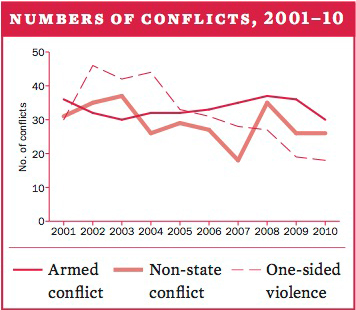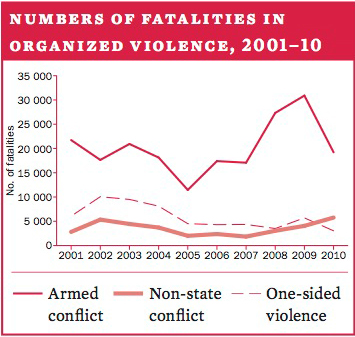2. Armed conflict
Overview, Neil Melvin [PDF]
I. The first year of the Arab Spring, Marie Allansson, Jonas Baumann, Samuel Taub, Lotta Themnér and Peter Wallenteen* [PDF]
II. Organized violence in the Horn of Africa, Jonas Baumann, Marcus Nilsson, Lotta Themnér and Peter Wallensteen* [PDF]
III. Patterns of organized violence, 2001–10, Lotta Themnér and Peter Wallensteen* [PDF]
IV. The Global Peace Index 2012, Camilla Schippa and Daniel Hyslop** [PDF]
* Uppsala Conflict Data Program
** Institute for Economics and Peace
Summary
During 2011 the sudden and dramatic popular uprisings in parts of the Middle East and North Africa, which together constituted the Arab Spring, produced diverse patterns of conflict. The events of the Arab Spring were not, however, isolated in terms of contemporary conflict trends. Rather, developments across the region served to underline some of the long-term changes that have occurred in armed conflict over recent decades. This has involved important shifts in the scale, intensity and duration of armed conflict around the world, and in the principal actors involved in violence. Together these changes point to the emergence of a significantly different conflict environment than that which prevailed for much of the 20th century.

The first year of the Arab Spring
The uprisings of the Arab Spring spread rapidly from country to country and soon affected large parts of North Africa and the Middle East. While they shared a number of traits—including large demonstrations, non-violent actions, the absence of single leaders and the use of central squares in major cities—they also differed in certain respects. The extent of the demands made by the protesters varied, ranging from improved economic situations to regime change, as did the level of violence.
While there were comparatively few fatalities in Algeria and Morocco, other countries—including Bahrain, Egypt, Tunisia and Yemen—were much more severely affected. The highest levels of violence were in Libya and Syria.
International reactions varied, with external support limited to a few cases. Western powers, notably France and the USA, initially supported governments in Egypt and Tunisia but then began to push for change. In the case of Libya, they quickly took an active stand against the regime, with the UN’s approval and NATO as the instrument. Over conflict in Syria, China and Russia, both of which had become increasingly critical of the international use of force, opposed Western-led efforts to sanction the ruling regime. The scope for third-party involvement in solving these crises was remarkably limited, and serious negotiations only occurred in Yemen.
The outcomes of the first year of the Arab Spring were mixed. There were examples of regime change but also cases where popular resistance was repressed. Nevertheless, Arab politics has been changed by this historically unique series of events.

Organized violence in the Horn of Africa
For decades, the countries in the Horn of Africa—Djibouti, Eritrea, Ethiopia, Kenya and Somalia—have been plagued by organized violence. While all these countries experienced state-based armed conflict, non-state conflict or one-sided violence against civilians during the decade 2001–10, non-state conflicts were by far the most common. There were 77 non-state conflicts (35 per cent of the global total) in the Horn of Africa. State-based armed conflict was less common: only 5 were recorded in 2001–10. Acts of one-sided violence were committed by 6 actors.
States in the region have demonstrated a growing tendency to become militarily engaged in neighbouring countries. For instance, both Ethiopia and Kenya have at times sent troops in support of the Somali Transitional Federal Government (TFG) in its conflict with al-Shabab, which has in turn received arms and training from Eritrea.
Patterns of organized violence, 2001–10
In previous editions of the SIPRI Yearbook, the Uppsala Conflict Data Program (UCDP) presented information on patterns of ‘major armed conflicts’. To provide a broader perspective on organized violence, the focus has now expanded to include three types of organized violence: (state-based) armed conflicts, non-state conflicts and one-sided violence (against civilians).
Over the period 2001–10 there were 69 armed conflicts and 221 non-state conflicts and 127 actors were involved in one-sided violence. Thus, in total, there were more than 400 violent actions that each resulted in the deaths of more than 25 people in a particular year.
The extent of organized violence at the end of the decade was lower than at its beginning, although the decline was not dramatic. Moreover, while in the 1990s there were wide fluctuations in the number of conflicts, this pattern was not repeated in the 2000s, indicating that the downward trend may be a promising sign of future developments.
The Global Peace Index 2012
The Global Peace Index (GPI), produced by the Institute for Economics and Peace, uses 23 indicators to rank 158 countries by their relative states of peace.
There were improvements in the overall scores of all regions apart from the Middle East and North Africa in the 2012 GPI. For the first time since the GPI was launched, in 2007, sub-Saharan Africa was not the least peaceful region. The events of the Arab Spring made the Middle East and North Africa the least peaceful region.
| Rank | Country | Score | Change |
|---|---|---|---|
| 1 | Iceland | 1.113 | –0.037 |
| 2 | Denmark | 1.239 | –0.041 |
| 2 | New Zealand | 1.239 | –0.034 |
| 4 | Canada | 1.317 | –0.033 |
| 5 | Japan | 1.326 | +0.032 |
| 154 | Congo, DRC | 3.073 | +0.057 |
| 155 | Iraq | 3.192 | –0.107 |
| 156 | Sudan | 3.193 | –0.038 |
| 157 | Afghanistan | 3.252 | +0.043 |
| 158 | Somalia | 3.392 | +0.021 |